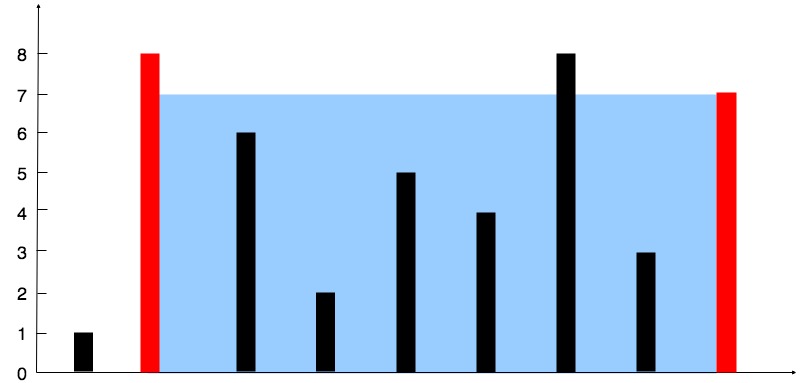LeetCode-in-All
11. Container With Most Water
Medium
Given n non-negative integers a1, a2, ..., an , where each represents a point at coordinate (i, ai). n vertical lines are drawn such that the two endpoints of the line i is at (i, ai) and (i, 0). Find two lines, which, together with the x-axis forms a container, such that the container contains the most water.
Notice that you may not slant the container.
Example 1:

Input: height = [1,8,6,2,5,4,8,3,7]
Output: 49
Explanation: The above vertical lines are represented by array [1,8,6,2,5,4,8,3,7]. In this case, the max area of water (blue section) the container can contain is 49.
Example 2:
Input: height = [1,1]
Output: 1
Example 3:
Input: height = [4,3,2,1,4]
Output: 16
Example 4:
Input: height = [1,2,1]
Output: 2
Constraints:
n == height.length2 <= n <= 1050 <= height[i] <= 104
Here are the steps to solve the “Container With Most Water” problem:
Approach:
- Initialize Pointers:
- Initialize two pointers, one at the beginning (
left) and one at the end (right) of the height array.
- Initialize two pointers, one at the beginning (
- Calculate Initial Area:
- Calculate the initial area between the two pointers using the minimum height (
min_height) and the width (width) between the pointers.
- Calculate the initial area between the two pointers using the minimum height (
- Move Pointers Inward:
- Move the pointer with the smaller height towards the center of the array.
- If
height[left] < height[right], incrementleft. - If
height[left] >= height[right], decrementright.
- If
- Move the pointer with the smaller height towards the center of the array.
- Update Maximum Area:
- Update the maximum area if the newly calculated area is greater than the current maximum.
- Repeat Until Pointers Meet:
- Repeat steps 3-4 until the pointers meet.
- Return Maximum Area:
- Return the maximum area.
Python Code:
class Solution:
def maxArea(self, height: List[int]) -> int:
# Initialize pointers
left, right = 0, len(height) - 1
max_area = 0
# Iterate until pointers meet
while left < right:
# Calculate width and minimum height
width = right - left
min_height = min(height[left], height[right])
# Update maximum area
max_area = max(max_area, width * min_height)
# Move pointers inward
if height[left] < height[right]:
left += 1
else:
right -= 1
# Return maximum area
return max_area
# Example Usage:
solution = Solution()
# Example 1:
height1 = [1, 8, 6, 2, 5, 4, 8, 3, 7]
print(solution.maxArea(height1)) # Output: 49
# Example 2:
height2 = [1, 1]
print(solution.maxArea(height2)) # Output: 1
# Example 3:
height3 = [4, 3, 2, 1, 4]
print(solution.maxArea(height3)) # Output: 16
# Example 4:
height4 = [1, 2, 1]
print(solution.maxArea(height4)) # Output: 2
This code defines a Solution class with a method maxArea that takes an array of heights as input and returns the maximum area that can be formed by a container. The example usage demonstrates how to create an instance of the Solution class and call the maxArea method with different inputs.

